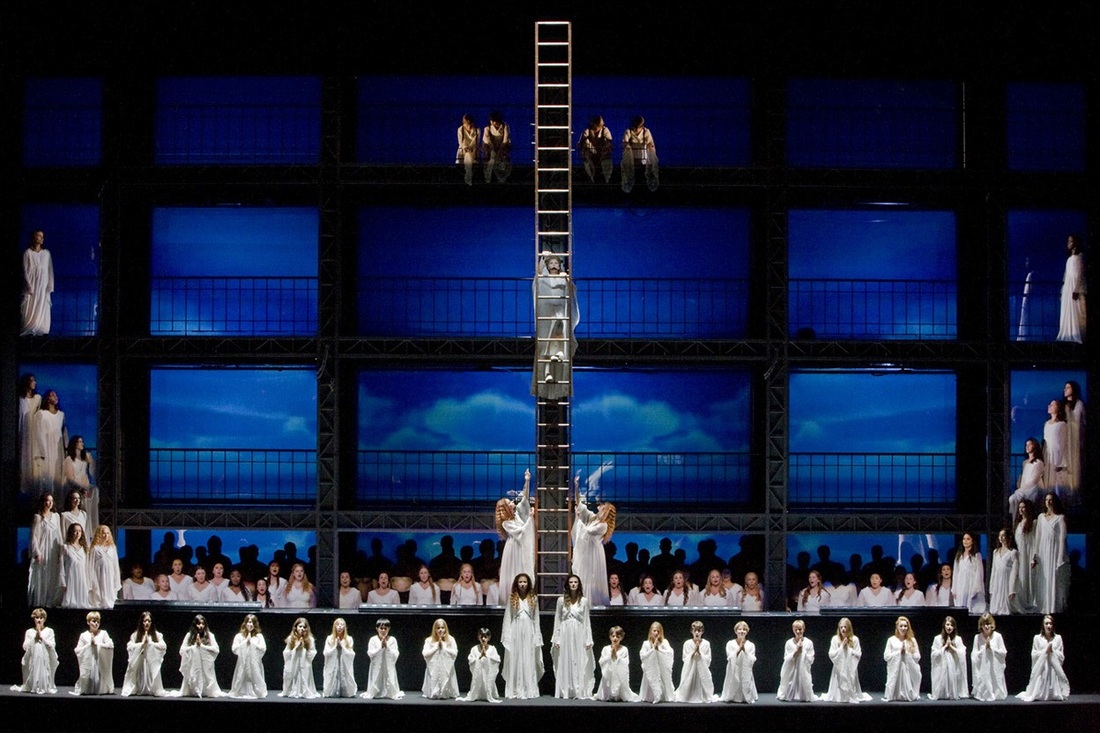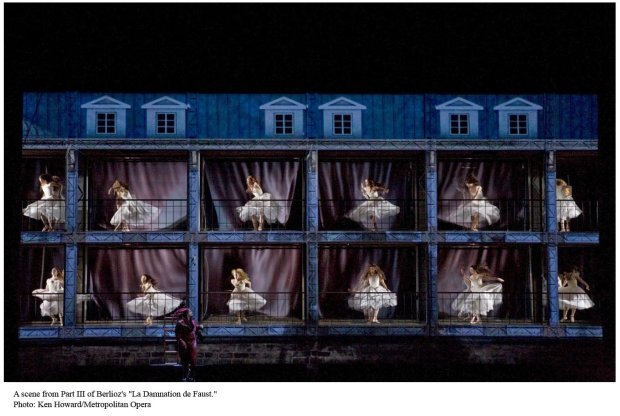La Damnation de Faust

Our second evening of operas at the Met was Robert Lepage's production of Berlioz's La Damnation de Faust. There really aren't enough superlatives to convey the genius of this production. Having seen it, I only wish I had seen the original run with Susan Graham as Marguerite and John Relyea as Mephistopholes. Instead, we had a cast of Olga Boradina (Marguertite), Ramon Vargas ((Faust) and IldarAbdrazakov (Mephistopholes). On the night we attended, the final night of the run, neither Borodina nor Vargas were in top voice, leaving Borodina's husband, Abdrazakov, to unexpectedly steal the night from two of the Met's top singers. However, Lepage and his production team Ex Machinaare the stars of this production that can be mind-boggling in its beauty and is a fantastic spectacle.
Like From the House of the Dead, La Damnation
de
Faust is also episodic in its dramatic structure but unlike Janacek's opera, in Berlioz's this doesn't detract from the overall strength of the work. This was the third production of Damnation I've seen and every one has been a satisfying dramatic and musical experience. The other two, however, can't compare to this one. Not much that I've seen can.
Against a wall of twenty-four squares that contain either people or video projections depending on the scene, the singers perform on the stage floor in front of the wall or on three catwalks above the stage. Ladders run up the center and sides. Acrobats walk up the wall, ballerinas dance and soldiers march backwards across the catwalk, parties erupt within the squares, an inferno appears from below. The technological aspects are stunning but it's really the creative vision that captivates the audience- and at every moment that vision works to convey the story and mood of the music. It's simply brilliant and the effect is similar to the incredible staging of
Radiohead's
2008 summer tour.
The success of this is all the more impressive when one considers Berlioz's Faust was not conceived to be an opera. It just happens to work as one, since the composer made great use of select parts of Goethe's work and composed some gorgeous music to bring it to life. Faust has four parts and eight scenes.
In the first, Vargas, resembling Karl Marx in a ridiculous wig and beard, contemplates life experiences he's never going to have. During this part, soldiers (looking very much like wind-up toys) march with perfect precision backwards across the catwalk to the score's Hungarian March. Faust is about to kill himself out of despair when Mephistopheles appears with the offer to good to refuse. Vargas loses the Marx costume and the two attend a riotous, lustful party at a pub that looked to me like a great place to spend New Year's Eve (or the onset of the Apocalypse), which Faust grows weary of (being more the romantic sort than a party-person). They then venture off to the Elbe, where Mephistipholes entices Faust with a vision of Marguerite, which of course, since this is opera, or at least 19th century literature, Faust immediately falls in love with the idea of her. I fell in love the choreography and imagery of the Will o' the Wisps- one of the most gorgeous sequences I've ever seen on a stage anywhere.
In the second half Vargas seemed to rely on the prompter with increasing frequency which I only noticed since I was in the seventh row. There was still much to captivate the eye, including projections of horses galloping across the stage which were soon mounted by acrobats and a number of crucified
Jesuses
hanging off the ladders. At the end, when
Borodina
ascended a ladder to heaven (which wobbled a bit under her), the tableau was incredibly striking and
Lepage
managed to make the second half as arresting as the first.
Advocates of "park and bark" (aka people who claim "opera is all about the singing") will understandably have qualms about a production which relies so heavily on technology and spectacle. Sorry folks, this is the future- and it looks fantastic to me. This is opera fully realized on the stage and I can't wait to see what this team comes up for the upcoming Ring they are currently creating for the Met. At last, there may actually be a Ring that really brings every element of Wagner's dramatic vision to full life (even if it's created via technology). When this production returns, don't miss it.
LA Opera's James
Conlon
led the orchestra through the graceful score with clarity and perfect timing.








